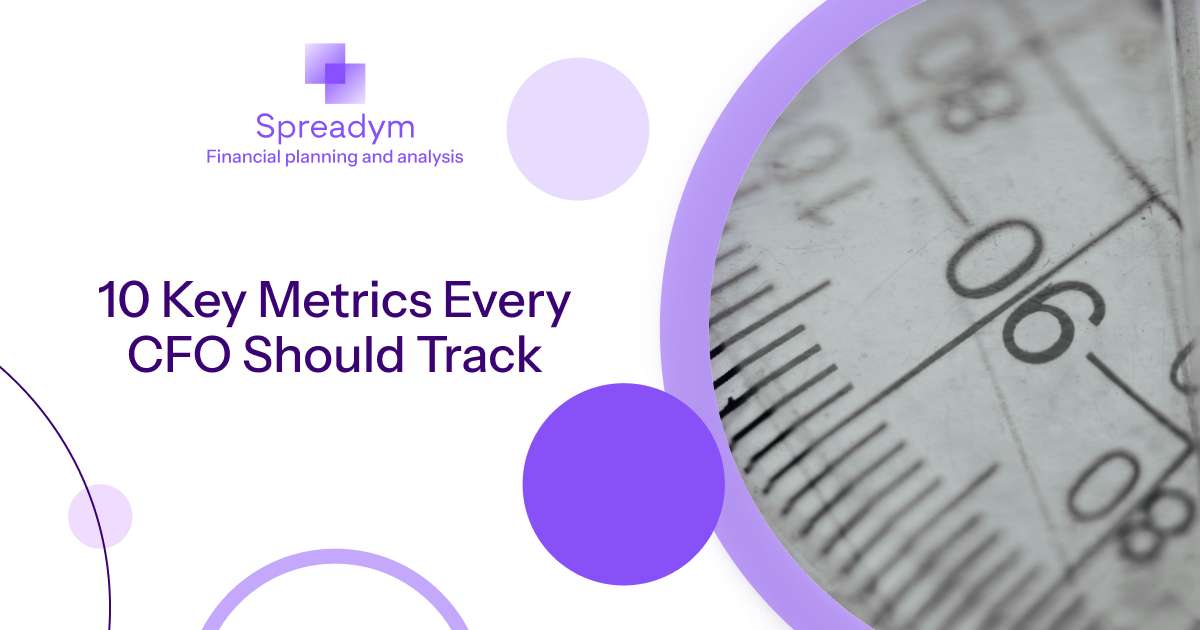Every business can and should tailor its own dashboard to match its strategic goals.
In a manufacturing company, for instance, cost of goods sold, production-plan attainment, and inventory levels are crucial.
In an IT firm, detailed tracking of payroll costs by employee and project allocation often comes to the fore.
Regardless of industry specifics, there is a core set of financial indicators that no finance leader can ignore.
Today’s post looks at those universal metrics in detail.
In a manufacturing company, for instance, cost of goods sold, production-plan attainment, and inventory levels are crucial.
In an IT firm, detailed tracking of payroll costs by employee and project allocation often comes to the fore.
Regardless of industry specifics, there is a core set of financial indicators that no finance leader can ignore.
Today’s post looks at those universal metrics in detail.
Core Financial Metrics
Operating Cash Flow (OCF)
How to Calculate: Net profit ± non-cash items (depreciation, impairment, etc.) ± change in working capital
Indicates whether the business generates enough cash to fund day-to-day operations without relying on external financing.
Free Cash Flow (FCF)
How to Calculate: OCF – CapEx (net investments in fixed assets)
Shows the cash available for dividends, debt reduction, and strategic investments.
EBITDA Margin
How to Calculate: EBITDA ÷ Revenue
A widely used measure of operating profitability, unaffected by capital structure or tax environment.
Gross Profit Margin
How to Calculate: (Revenue – Cost of Goods Sold) ÷ Revenue
Assesses pricing discipline and efficiency in procurement/production; an early warning of cost pressure or price competition.
Net Profit Margin
How to Calculate: Net profit ÷ Revenue
Reveals the ultimate profitability after all expenses, taxes, and interest.
Return on Invested Capital (ROIC)
How to Calculate: Net Operating Profit After Tax (NOPAT) ÷ (Debt + Equity – Non-operating assets)
Relates earnings to the capital employed; a primary test of value creation versus the company’s weighted average cost of capital (WACC).
Cash Conversion Cycle (CCC)
How to Calculate: Days Sales Outstanding + Days Inventory Outstanding – Days Payable Outstanding
Measures how long cash is tied up in inventory and receivables before it returns as cash; key to working-capital optimization.
Net Debt / EBITDA
How to Calculate: (Total debt – Cash) ÷ EBITDA
Provides a quick view of leverage and the company’s ability to service debt, smoothing out profit seasonality.
Interest Coverage Ratio
How to Calculate: EBIT ÷ Interest expense
Confirms that operating profit is sufficient to cover interest payments; critical for rating agencies and lenders.
Budget-vs.-Actual Variance
How to Calculate: (Actual – Budget) ÷ Budget for key lines such as revenue, OPEX, CapEx, and cash flows
Gauges forecasting accuracy, highlights inefficiencies, supports timely re-forecasting, and strengthens investor confidence.
By tracking these ten indicators consistently—and setting target ranges for each—a CFO gains a clear, actionable view of liquidity, profitability, capital efficiency, and planning discipline across the organization.
How to Calculate: Net profit ± non-cash items (depreciation, impairment, etc.) ± change in working capital
Indicates whether the business generates enough cash to fund day-to-day operations without relying on external financing.
Free Cash Flow (FCF)
How to Calculate: OCF – CapEx (net investments in fixed assets)
Shows the cash available for dividends, debt reduction, and strategic investments.
EBITDA Margin
How to Calculate: EBITDA ÷ Revenue
A widely used measure of operating profitability, unaffected by capital structure or tax environment.
Gross Profit Margin
How to Calculate: (Revenue – Cost of Goods Sold) ÷ Revenue
Assesses pricing discipline and efficiency in procurement/production; an early warning of cost pressure or price competition.
Net Profit Margin
How to Calculate: Net profit ÷ Revenue
Reveals the ultimate profitability after all expenses, taxes, and interest.
Return on Invested Capital (ROIC)
How to Calculate: Net Operating Profit After Tax (NOPAT) ÷ (Debt + Equity – Non-operating assets)
Relates earnings to the capital employed; a primary test of value creation versus the company’s weighted average cost of capital (WACC).
Cash Conversion Cycle (CCC)
How to Calculate: Days Sales Outstanding + Days Inventory Outstanding – Days Payable Outstanding
Measures how long cash is tied up in inventory and receivables before it returns as cash; key to working-capital optimization.
Net Debt / EBITDA
How to Calculate: (Total debt – Cash) ÷ EBITDA
Provides a quick view of leverage and the company’s ability to service debt, smoothing out profit seasonality.
Interest Coverage Ratio
How to Calculate: EBIT ÷ Interest expense
Confirms that operating profit is sufficient to cover interest payments; critical for rating agencies and lenders.
Budget-vs.-Actual Variance
How to Calculate: (Actual – Budget) ÷ Budget for key lines such as revenue, OPEX, CapEx, and cash flows
Gauges forecasting accuracy, highlights inefficiencies, supports timely re-forecasting, and strengthens investor confidence.
By tracking these ten indicators consistently—and setting target ranges for each—a CFO gains a clear, actionable view of liquidity, profitability, capital efficiency, and planning discipline across the organization.


